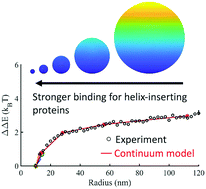A continuum membrane model can predict curvature sensing by helix insertion†
Abstract
Protein domains, such as ENTH (epsin N-terminal homology) and BAR (bin/amphiphysin/rvs), contain amphipathic helices that drive preferential binding to curved membranes. However, predicting how the physical parameters of these domains control this ‘curvature sensing’ behavior is challenging due to the local membrane deformations generated by the nanoscopic helix on the surface of a large sphere. We here use a deformable continuum model that accounts for the physical properties of the membrane and the helix insertion to predict curvature sensing behavior, with direct validation against multiple experimental datasets. We show that the insertion can be modeled as a local change to the membrane's spontaneous curvature, cins0, producing excellent agreement with the energetics extracted from experiments on ENTH binding to vesicles and cylinders, and of ArfGAP helices to vesicles. For small vesicles with high curvature, the insertion lowers the membrane energy by relieving strain on a membrane that is far from its preferred curvature of zero. For larger vesicles, however, the insertion has the inverse effect, de-stabilizing the membrane by introducing more strain. We formulate here an empirical expression that accurately captures numerically calculated membrane energies as a function of both basic membrane properties (bending modulus κ and radius R) as well as stresses applied by the inserted helix (cins0 and area Ains). We therefore predict how these physical parameters will alter the energetics of helix binding to curved vesicles, which is an essential step in understanding their localization dynamics during membrane remodeling processes.



 Please wait while we load your content...
Please wait while we load your content...
